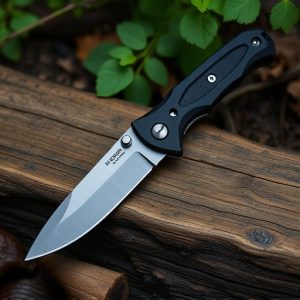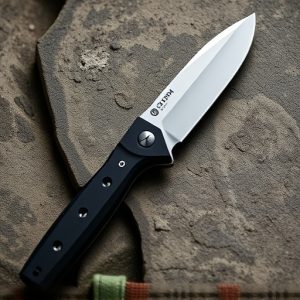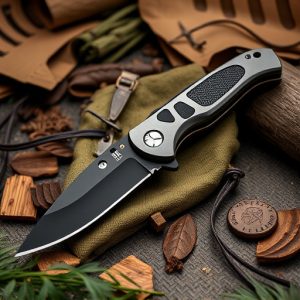Mastering the Mechanics and Regulations of OTF Automatic Knives: An In-Depth Guide
The OTF (One-Time-Fly) automatic knife is a sophisticated tool that combines innovative engineering…….
The OTF (One-Time-Fly) automatic knife is a sophisticated tool that combines innovative engineering with sleek design, offering a swift and precise blade deployment activated by a handle button. These knives utilize either tightly wound springs or compressed gas mechanisms to extend the blade, ensuring consistent performance through a balanced energy system. Safety features such as locking mechanisms are integral to prevent accidental activation. The OTF knife has evolved significantly over time, enhancing its durability with high-strength metals and improving its functionality with ambidextrous designs and streamlined deployment processes. Despite these advancements, it's crucial for users to understand the legal implications of owning an OTF automatic knife, which can vary by jurisdiction. Users must comply with local laws, secure necessary licenses or permits, and stay updated on legislative changes. Safety is paramount when handling these knives; users should be knowledgeable about their mechanisms for responsible use, routine maintenance to maintain functionality, and storage practices to prevent unauthorized access. Adhering to legal requirements and safety protocols is essential for the safe and compliant ownership of an OTF automatic knife.
Explore the intricacies and dynamics of the OTF automatic knife, a marvel of modern engineering. This article delves into the mechanics that drive these sleek devices, tracing their evolution and showcasing the innovative designs that have shaped them. From the initial concept to the latest models, we will navigate through the technical advancements that have made OTF knives both a utility tool and a collector’s item. Moreover, we address the critical legal considerations and safety protocols essential for responsible ownership of these automatic wonders. Join us as we unravel the world of OTF automatic knives, ensuring an informed understanding of their place in both practical and enthusiast contexts.
Understanding the Mechanics of OTF Automatic Knives
The automatic out the front (OTF) knife is a sophisticated piece of engineering that combines both form and function. At its core, an OTF knife operates via a series of tightly wound coiled springs or compressed gas mechanisms that propel the blade forward with a swift push of a button located on the handle. This action deploys the blade in a smooth and rapid motion, making it readily available for use. The mechanics of an OTF knife are intricate, involving a precise balance between the energy stored in the spring or gas and the friction within the system that controls the blade’s movement. This ensures a reliable and consistent deployment every time, which is essential for users who require quick and dependable access to the blade in various situations.
The design of an OTF knife also incorporates safety features such as locking mechanisms that prevent accidental deployments or closures. These features are crucial for ensuring user safety and are often integrated into the handle’s structure. The durability and precision of these knives make them a popular choice among collectors, enthusiasts, and professionals who rely on their tools in high-stress environments. Understanding the mechanics behind OTF automatic knives is key to appreciating their complexity and the care that goes into their manufacture. This knowledge also empowers users to maintain and operate their knives effectively, ensuring longevity and optimal performance.
The Evolution and Design Innovations of OTF Knives
Over the years, the design and evolution of OTF, or Out The Front, automatic knives have seen significant advancements, driven by both technological progress and the shifting needs of users ranging from military personnel to everyday carriers. The initial concept of an OTF knife involved a blade that extended straight out from the handle, eliminating the need for manual deployment mechanisms like thumb studs or flippers. This innovation offered swift and reliable access to the blade, which was particularly advantageous in combat or survival situations. As the demand for such knives grew, manufacturers began incorporating various design innovations to enhance performance, durability, and safety.
Today’s OTF automatic knives boast a blend of materials and engineering that were once the realm of science fiction. High-strength metals ensure the blades can withstand rigorous use without compromising on sharpness or edge retention. Advanced bearings facilitate a smoother, faster deployment, often with a single press of a button. Ambidextrous design options cater to users of both left and right hand orientations. Additionally, safety features such as locking mechanisms have been integrated to prevent accidental opening or closing of the knife. The continuous pursuit of perfection in the OTF automatic knife market has led to a diverse array of models, each offering unique features that appeal to different user preferences and needs. These advancements underscore the ongoing evolution of this niche but significant category within the broader field of knife technology.
Legal Considerations and Safety Protocols for OTF Automatic Knife Owners
When incorporating an OTF automatic knife into your collection or everyday carry, it’s imperative to be well-versed in the legal landscape governing their possession and use. Laws regarding automatic knives can vary significantly by jurisdiction, with some regions permitting them under certain conditions while others may impose strict restrictions or outright bans. Owners must diligently research and adhere to local, state, and federal regulations to avoid unintended legal complications. This due diligence includes understanding the classifications of these knives, obtaining any necessary licenses or permits, and staying abreast of any legislative changes that could affect their status as legal owners.
Safety protocols are equally paramount for OTF automatic knife users. These sophisticated tools require responsible handling to prevent accidents. Users should familiarize themselves with the mechanical workings of their knife to ensure they can safely deploy and retract the blade. Regular maintenance is crucial to keep the knife functioning correctly; lubrication, cleaning, and inspection are routine tasks that extend the lifespan of the knife and minimize the risk of malfunction during use. Additionally, users must exercise caution in how they carry and handle their OTF knife, always keeping it out of reach of unauthorized individuals, especially children. Safety training, understanding the legal boundaries, and maintaining a commitment to responsible ownership are all critical aspects of being an OTF automatic knife owner.


